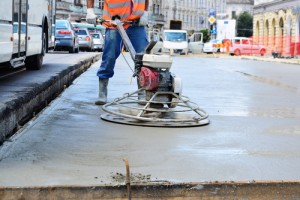A power trowel, walk-behind trowel, or trowel machine, may have many different names, but their job is to create a level, smooth concrete surface such as a patio slab or interior floor. Different jobs require different types of trowels, however. And, different types of blades. Here’s a quick overview of how to choose the correct trowel and blade set-up for the job and how to get the best results.
- Choosing a trowel machine
If the area of concrete you want to level is less than 1000-square feet, a pushable trowel will do the job. For larger slabs, you may want to get a riding trowel. For these smaller jobs, blades will typically need to be between 24 and 36-inches. You have a couple of different options for the type of blade needed. You could get two types, both float and finish blades, or you could get a hybrid called a combined blade that can smooth concrete in just one pass. On larger jobs, your blades should be between 36 and 48-inches, except on corners where you’ll want to switch to a 24-inch blade.
- Testing concrete
Determining the perfect time to begin troweling your concrete slab is a bit of an art form. Those who have been working with concrete for years will be able to tell when it’s ready, but if you’re an amateur, you’ll want to carefully test as you learn. In most cases, the concrete will need to be poured a few hours before you begin working with the trowel. It should be firm enough to support weight, but obviously not completely set. A good test is to simply step onto the slab then step off. If the footprint you leave is 1/8-inch or less, the concrete is firm enough to begin troweling.
- Floating
Using blades specifically designed to float your concrete, or using combined blades, will allow you to smooth out bumps, hollows and any general uneven areas. There’s more to effective floating than just the blades on your trowel machine, however. You should also run the trowel at 3/4 speed and keep blades flat. This helps to keep the machine from digging into the concrete and ruining your progress. Once you’ve gone up and back over the entire slab, turn perpendicular and go across the entire slab. This technique will help to finish any spots that were missed on the first pass.
- Finishing
If you were using the float blades, you can now change to the finish blades. If you chose the combined blades for floating, however, they can stay on for this step. Rather than keeping the blades flat, however, you’ll want to run them at full pitch and at full speed. When finishing and sealing the porous concrete, you’ll want to apply the most pressure possible to the slab. You’ll want to use the same perpendicular technique as you did when floating, but you may need to make several passes. You’ll continue until you get the finish you want, be it glossy or matte.
In addition to these tips for effectively using a power trowel, you’ll also want to use safety precautions like goggles, ear protection, work gloves and steel toed boots.
For all the equipment needed for a successful concrete project, from trowel machines, to cement, to safety equipment, come see us at Maxwell Supply in Tulsa.
